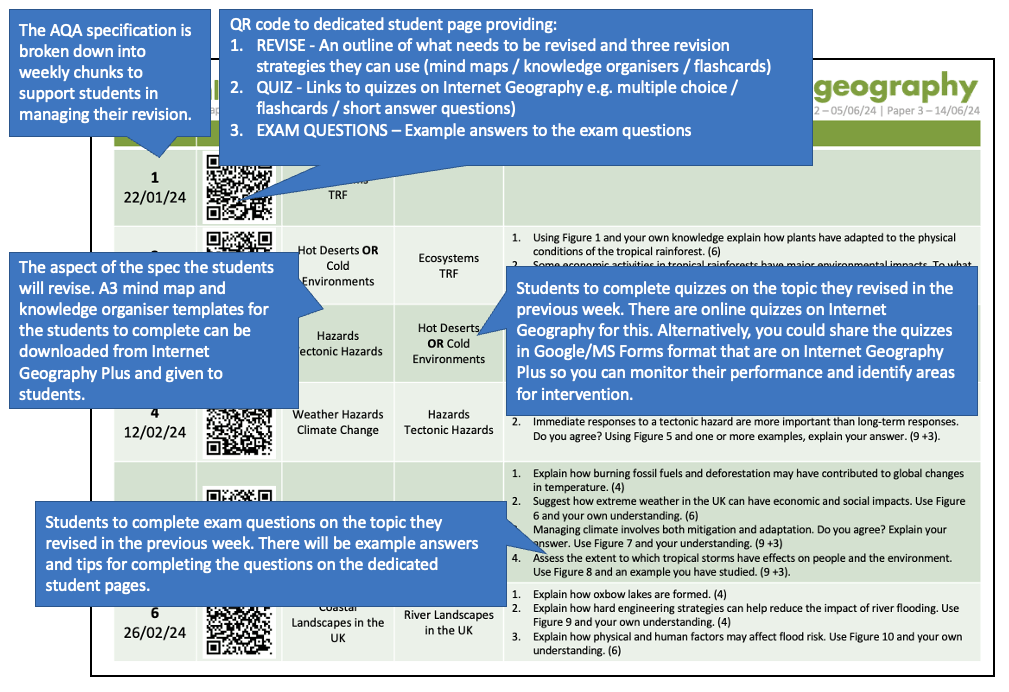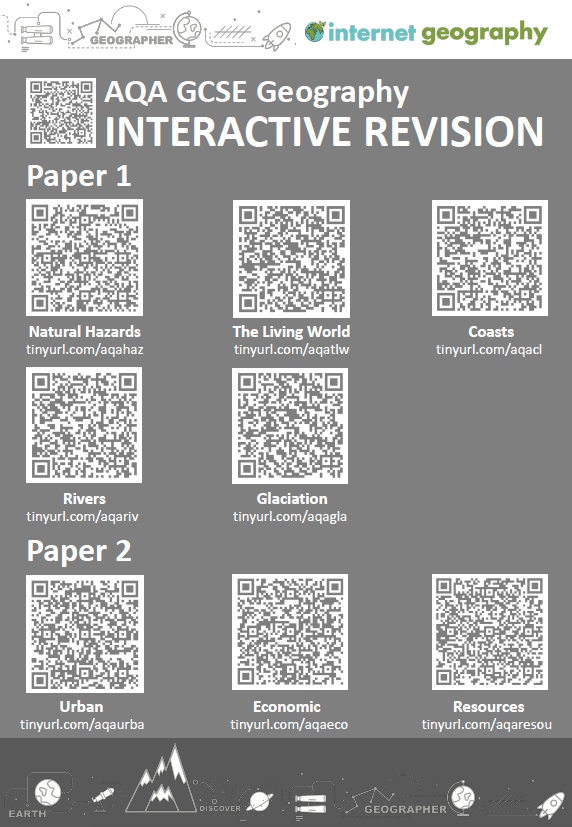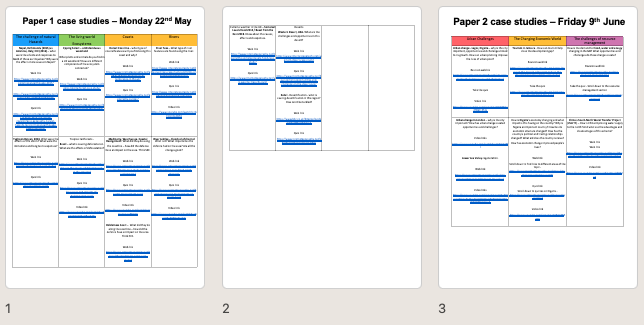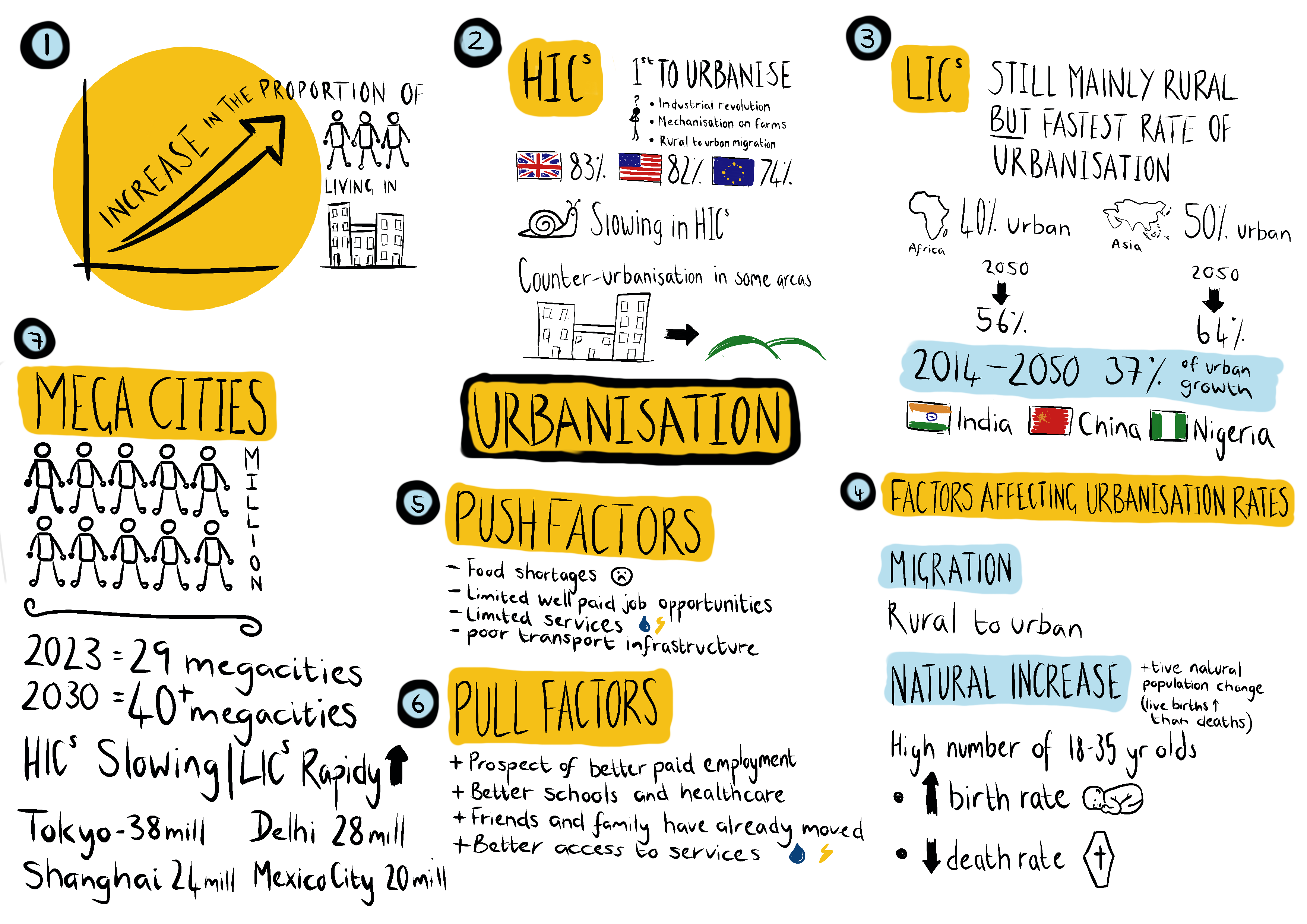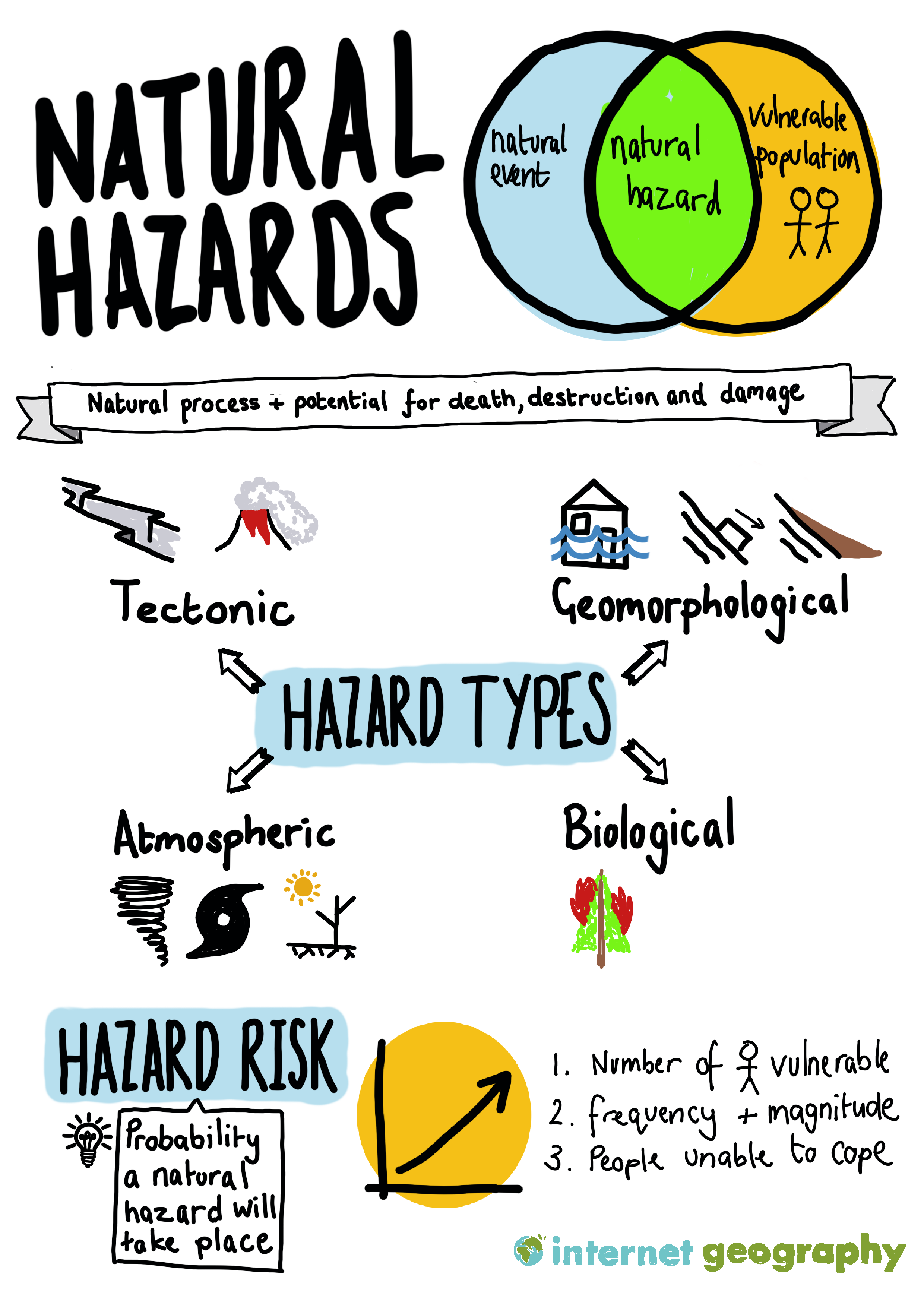What is The Final Countdown?
The Final Countdown is a comprehensive set of resources to support students in the run-up to exams. The work of JB GeogTeacher inspired the initiative.
The Final Countdown has been created to provide students with weekly revision activities in the run-up to the AQA GCSE Geography exams in May and June 2023. Each set contains a six-week revision plan to support students in organising their revision. In addition, each week has a QR code to online resources, guides, quizzes and exam questions (including example answers and mark schemes) for students to use to prepare for their final exams.
The image below illustrates how The Final Coundown works.
Internet Geography Plus subscribers can access the six-weekly revision sheets now.
Each week, revision is divided into three sections: revise, quiz and exam questions.
Revise
Students revise an area of the specification, and the QR code will take them to a menu of pages on Internet Geography to support this. In addition, we’ve provided A3 templates for the students to use to structure their revision. These include knowledge organisers and mind maps. The image below shows examples.
Internet Geography Plus subscribers can download all knowledge organisers, and mind maps from The Final Countdown page on Internet Geography Plus.
Review
Review allows students to revisit their learning by completing online multiple-choice quizzes to test their knowledge. These are all available on Internet Geography for free. Alternatively, Plus subscribers could direct their students to the Internet Geography Plus MS/Google Forms quizzes to monitor progress (and completion!).
Exam Questions
Finally, students complete exam questions based on the area they revised the previous week. To support students, examples of answers to each question are published on each revision page. You can see a sample here.
Internet Geography Plus subscribers can access the resources here. However, if you’re not a subscriber, why not join to access this and over one thousand other resources? Please take a look at our subscription options.
If you have any questions, drop us an email.
AQA GCSE Geography Interactive Revision Resources
Did you know? Students can access a growing collection of free interactive resources on Internet Geography to support revision and retrieval.
We’ve compiled a PDF file you can share with students containing QR codes and short URLs so they can get straight to the area they want to revise. Just click the image below to download.
Case Studies and Examples with Web Links
Jason Bowsley of Baysgarth School has kindly shared a useful editable document to support students with case studies and examples, including the name of case studies/examples for each section of the specification with a web link, quiz link and video link.
Click the image above to download, and give Jason a follow on Twitter.
Sketch Notes in Geography
Geography is a fascinating subject that helps us understand our world. There is much to learn from studying natural resources, climate patterns, and human geography. However, it can also be challenging, with much information to remember (most GCSE specifications have too much content!). In all honesty, I have often struggled to retain key facts and figures about geography (and other aspects of life!). My children often joke that I have a terrible memory. Having seen several posts on social media about the power of sketch notes, I decided to investigate further. Sketch notes are a visual way of taking notes that involve drawing and writing to represent information clearly and concisely. Instead of just writing down words or phrases, sketch notes use images and symbols to represent ideas, making remembering and recalling them easier.
Below is my first attempt at a sketch note covering urbanisation. I still have a few tweaks (the data for megacities needs some work to make it more ‘sticky’), so let’s call it a first draft. Please, don’t judge my dodgy drawing skills and left-handed scrawl!
The sketch note above was created using Procreate on an iPad. However, sketch notes can just as easily be created using other apps or with paper and felt tips or the holy grail of geography, pencil crayons.
The sketch note below was also created using Procreate on an iPad. However, it could easily be produced using paper and pens.
I’ve found several advantages and disadvantages to using sketch notes. Let’s focus on the positives first. The first benefit I found was that I could recall the information on the sketch note. Several days after creating the sketch note, I could recall all the key statistics, and for someone with the short-term memory of a sieve, I was pretty blown away by this. Secondly, creating the sketch note made me carefully consider the information I would include and plan the sketch note. This process made me evaluate the information I had at hand (for the experiment, I used a GCSE Geography revision book) and carefully consider the most important information I should include. At the moment, I’m thinking batch-making sketch notes and giving them to students will remove some of their power. Lastly, I was proud of my first attempt and felt engaged and motivated to explore this technique further (and write this blog post about it!). I’ve come across lots of educational snake oil in my time, and this is not an example. I’ve concluded that this is a powerful tool for improving recall. I’d be interested in exploring its wider application (any geography departments interested in exploring this, do let me know!).
On to the disadvantages. The sketch note took me quite some time to create. I redrafted several areas and didn’t quite get the layout right the first time. Perhaps this is part of the learning experience, and I will get it right next time now I have a bit of experience. Also, my drawing skills are not the best so I had to get some inspiration from the Internet. I’ve started creating a cheat sheet with images and icons I can use next time to overcome this. The perfectionists out there might find this challenging. Because I created this on an iPad, I spent too much time redrafting sections of the sketch note. Perhaps committing it to paper might make me less fussy about it looking ‘perfect’.
Using sketch notes for revision in geography could be an effective way to help students retain key information. With the vast amount of data and concepts to remember in geography, it can be difficult to keep everything straight in one’s head. Sketchnotes can help to organise this information into a visual format, making it easier to understand and remember.
For example, when studying urbanisation, there are many key facts and figures to remember, such as the percentage of the world’s population that lives in urban areas and the rate of urbanisation in different regions. Using sketch notes, students can create diagrams, charts, and maps to represent this data visually. They can also use symbols and images to represent key concepts, such as the impact of urbanization on the environment and society.
In addition to helping with memory, sketch notes can be a fun and engaging way to revise geography. Students can use different colours and styles to create visually appealing notes that they are more likely to enjoy reviewing. This can help to make revision less stressful and more enjoyable.
To start with sketch notes, students can create a basic layout for their notes. This might include a central theme or topic, with different branches representing key concepts or subtopics. They can then use images and symbols to represent these ideas, with arrows and lines connecting them to show the relationships between concepts.
When revising geography, it is important to focus on understanding key concepts and their relationships rather than just memorising facts and figures. Sketchnotes can help students to do this by breaking down complex ideas into simpler components and representing them visually. This can help to create a deeper understanding of the subject matter, which is essential for success in geography.
I would be tempted not to launch using sketch notes with students close to final exams. They will likely struggle to get through the content. Instead, I’d be tempted to teach them how to use sketch notes early on in the course and then set it as regular homework or, if you have time, have review lessons where the students can summarise learning using the technique.
I’d be interested in hearing your thoughts on using sketch notes. If it is something you’d like to try, please drop me an email. If there’s enough interest, I’d happily put together some guides and cheat sheets to support your students using the technique.
Update – 14th March 2023: I’ve started assembling a guide to creating sketchnotes for revision on Internet Geography. In addition, Internet Geography Plus subscribers can now download an editable guide to creating sketchnotes (you need to be logged in to download) that can be shared with students to guide them through the process.
Anthony
New GCSE geography retrieval revision
We are developing a new, open access revision area on Internet Geography, to support students with retrieval practice. The resources will consist of a bank of online gap-fill activities that students can use to revisit prior learning.
The activities will be freely available with no requirement to register, pay to access or log in.
Each gap-fill will come in two forms, an open gap fill where students need to recall keywords and factual information along with a drag and drop version. The two versions are illustrated below.
We’re seeking support from the geography teacher community to develop these revision activities by contributing a paragraph or two of text to summarise key elements of each GCSE geography unit across all exam boards.
When contributing just head over to the submission form and add your paragraph. When contributing your paragraph missing words should be enclosed within an asterisk. e.g. *Constructive* waves build beaches. These waves are more common in *summer* than in winter. Constructive waves predominate in calmer weather conditions when less energy is being transferred to the water. Each wave is low. As the wave *breaks* it carries material up the beach in its *swash*. The beach material will then be deposited as the backwash soaks into the sand or slowly drains away. When the next wave breaks its swash will deposit more material without it being ‘captured’ by the backwash of the preceding wave.
Alternative answers should be separated using a forward slash e.g. *conservative/passive* plate margins….
You can also add a tooltip (pop up hint) to support students with the answer by including a colon e.g. *conservative/passive:Where to plates slide past each other* plate boundaries.
To begin with will focus on one unit at a time for each exam specification. To avoid repetition please identify the paragraph you will complete on this Google Sheet. When you’ve submitted it using this form please indicate it has been completed on the Google Sheet.
If you’ve any questions, please contact by adding a comment below.
Many thanks,
Anthony
GCSE Geography Homework Resources by Mr McAllister
Adam McAllister AKA @McAllister_Geog has produced a set of GCSE homework activities that he’s kindly agreed to share on Internet Geography.
Feeling really creative today! These have taken much longer than planned! Produced around 40 of these GCSE aimed homework sheets. Happy to share if wanted. 😍👨🏫🌎😍😍😍😍😍 #geographyteacher pic.twitter.com/33yqJHUWLr
— Mr McAllister 🌎👨🏫 (@McAllister_Geog) April 2, 2020
There are 40 resources to download so they have been compressed into a Zip file. The file size is around 20MB. You can download it below.
Adam also recently wrote a blog post for Internet Geography sharing a strategy for interpreting graphs using TEA analysis which is well worth a read!
If you have resources to share please drop us an email via [email protected]


